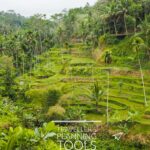last updated: November 2023
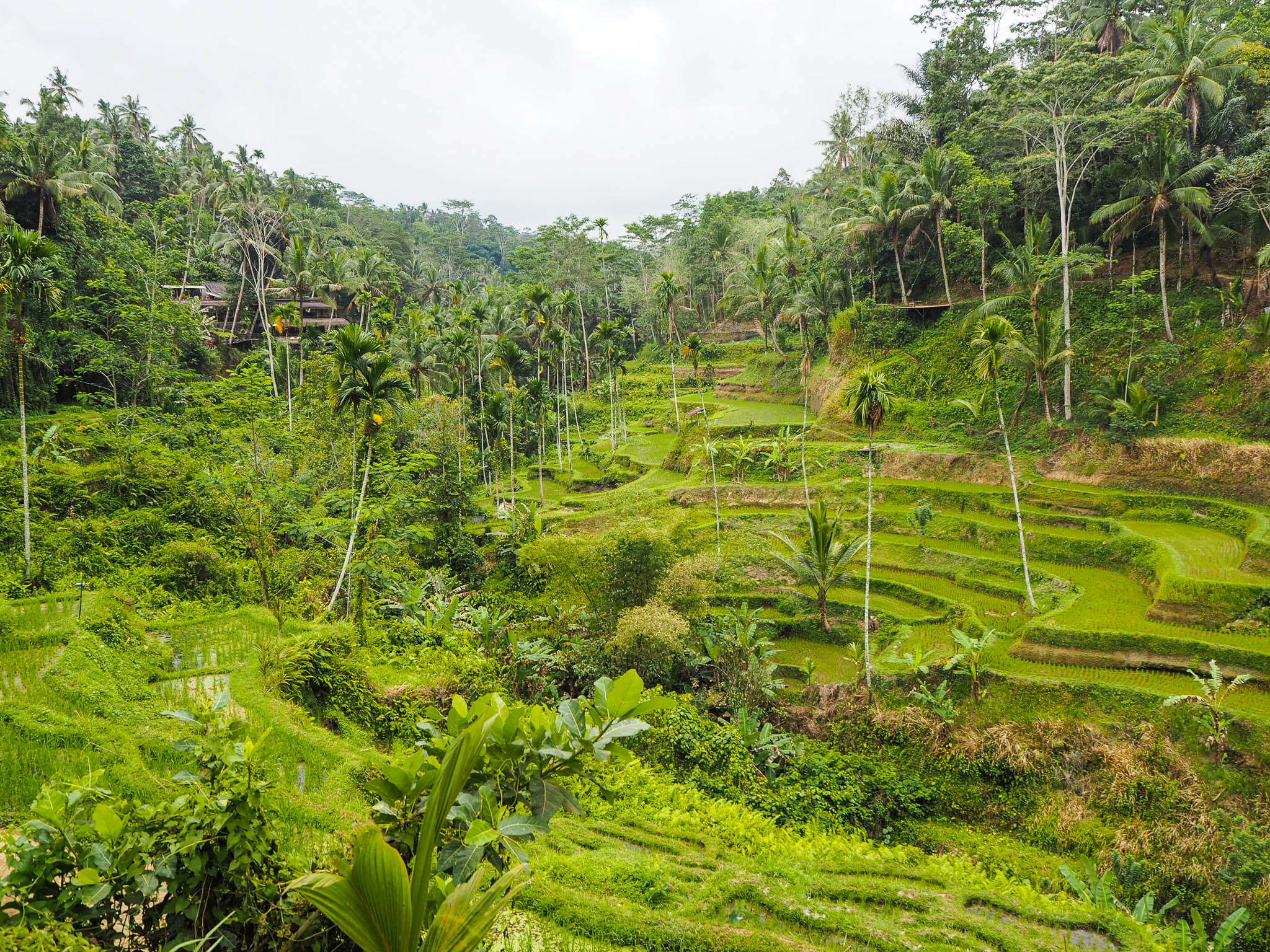
If you are reading this post, you probably already know what sustainable travel is and why we need to care about it. But let’s define it anyway. Sustainable travel is the ideological basis on which practical ways are founded for travellers to have a long-term positive impact to the natural environment, local society and economy of the places they visit.
It is common sense, really, that we should aim towards sustainable living, both at home and while abroad:
(a) We should care for this planet simply because it is our one and only home. Who wants to live in a dirty, miserable house?
(b) We should care for our fellow human beings who, in today’s globalised world, are all our neighbours. Remember how quickly COVID-19 spread throughout the world?
The great thing about sustainable travel is that it is not only beneficial for the place one travels to and the people the traveller comes in contact with. It also benefits the travellers themselves, since it enables a more relaxed, affordable and authentic travelling experience.
Sustainable travel is usually the effect of leading our everyday life in line with sustainability practices. However, sustainable travel can sometimes be the cause. In this blog post, you will find easy and practical tips to travel sustainably which, in turn, can encourage you to invite even more sustainable practices into your everyday life.
Let’s start.
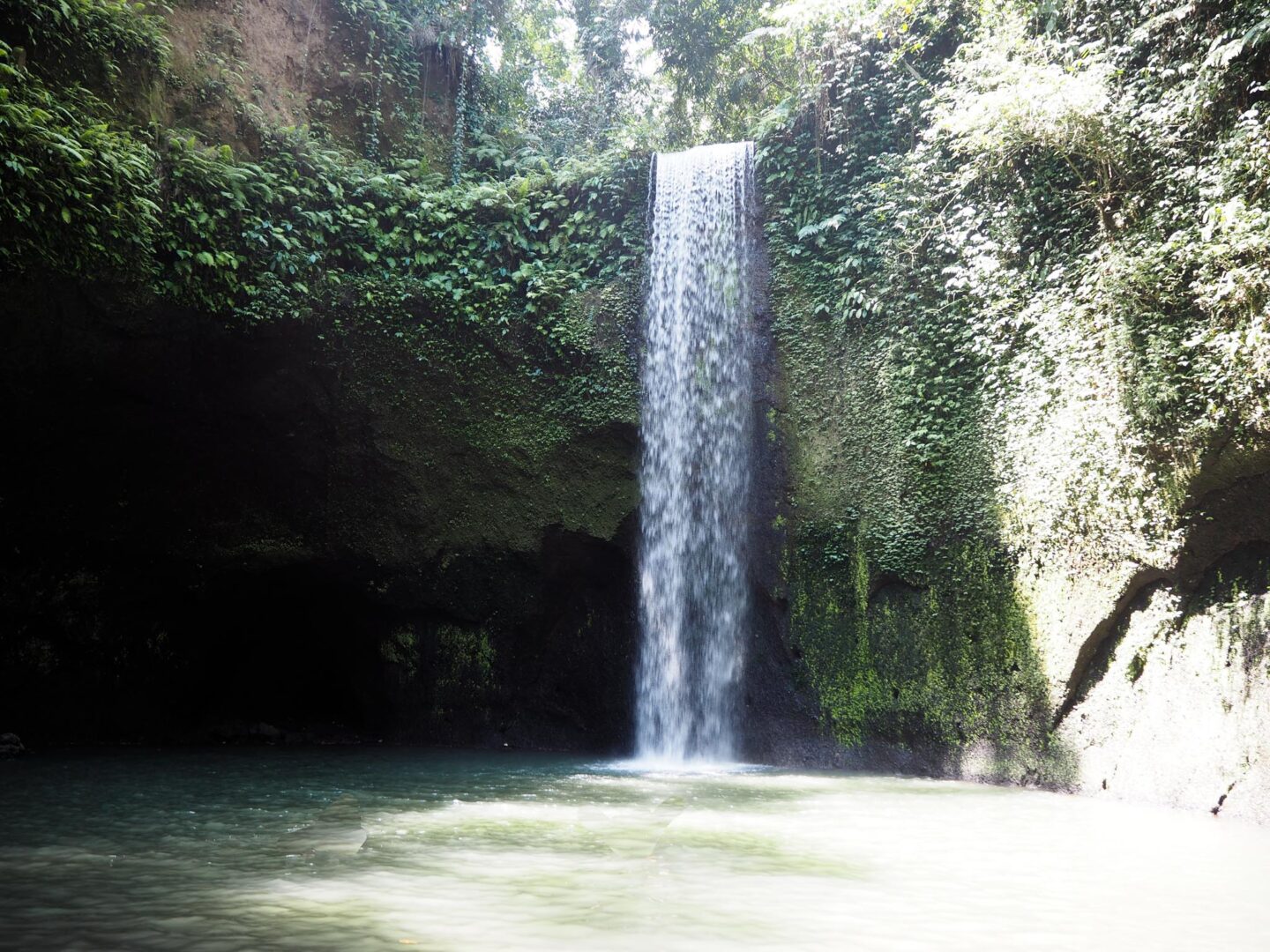
PLANNING YOUR TRIP
TIP NO 1: TRAVEL OFF-SEASON
Do a 5-minute research as to which month(s) is / are considered as high season in the location you want to visit. Book your trip for any time but that. This will benefit you in two ways:
- You will save so much money.
- The crowd-free experience will enhance your trip so much more.
I visited Venice (a great example for over-tourism) in November. It was cold and the humidity made it feel worse. Yet, in a city, we are always close to climate-controlled environments, so it didn’t matter that much. Our flights and hotels were very affordable. It was also so wonderful; no cruise ships or large hordes of tourists in sight.
If your trip is weather dependant, then, it is likely that high season coincides with the best weather conditions. And who wants to miss that? In that case, consider avoiding the peak season rather than travelling completely off-season. Let me give you two examples:
Example No 1: The peak season for the Greek islands is mid-July to mid-August, yet the weather is perfect from beginning of June to the end of September (which is the official ‘summer season’ -read all about it here).
Similarly, for many destinations, you can also consider what is called the ‘shoulder season’.
Example No 2: High season in the Caribbean is during the northern hemisphere’s winter. However, I have visited the Caribbean islands in May many times, always enjoying glorious weather and lower prices.
WHY IS TRAVELLING OFF-SEASON A MORE SUSTAINABLE FORM OF TRAVEL?
How are cheaper flights and room rates related to sustainability, you may ask? Well they are not. However, a steady and continuous influx of tourists gives a steady and continuous income to the locals involved in tourism. This encourages professionalism and year-round investment from their behalf. It also discourages those who are trying to make ‘a quick buck’. In that way, the local economy flourishes and travellers receive better service. Also, a steady flow of travellers, puts less pressure on local infrastructure and the natural environment.

Travelling off-season: Blissful peace and quiet at the end of the tourist season in Love Beach, Antigua, Lesser Antilles.
TIP NO 2: CONSIDER SLOW TRAVEL
Slow travel advocates for spending more time in a single place and being in transit less. In that way, you are able to become more in tune with the rhythm and culture of the destination. Maybe you have the time to engage with the locals, make some new friends. Most importantly, it allows you to take your time and not rush from place to place in order to tick things off your list.
Slow travel is like an immersion process. Starting off within a couple of hundred meters of where you are staying and moving further out at a gentle, relaxed pace. This slow exploration is in direct contrast to conventional travel that seeks to ‘hit’ the major tourist features. Slow travellers can take a day off from sightseeing, sleep in, relax and plan their itinerary based on the things they want to do rather than the things they have time for.
WHY IS TRAVELLING SLOW A MORE SUSTAINABLE FORM OF TRAVEL?
How is slow travel related to sustainability? Well, when you give yourself more time to explore your destination, you are able to visit less popular sights that not many go to. You can also head to the popular ones at off-peak hours and avoid contributing to over-tourism. You will have time to explore the area near your rental home further. Visit small local tavernas or cafés and not just the famous centrally located restaurant taking bookings months in advance.
Consequently, you support the local community more holistically. Having time to chat and frequent with the locals may also make you more aware of their problems and even inspire you to help in meaningful ways.
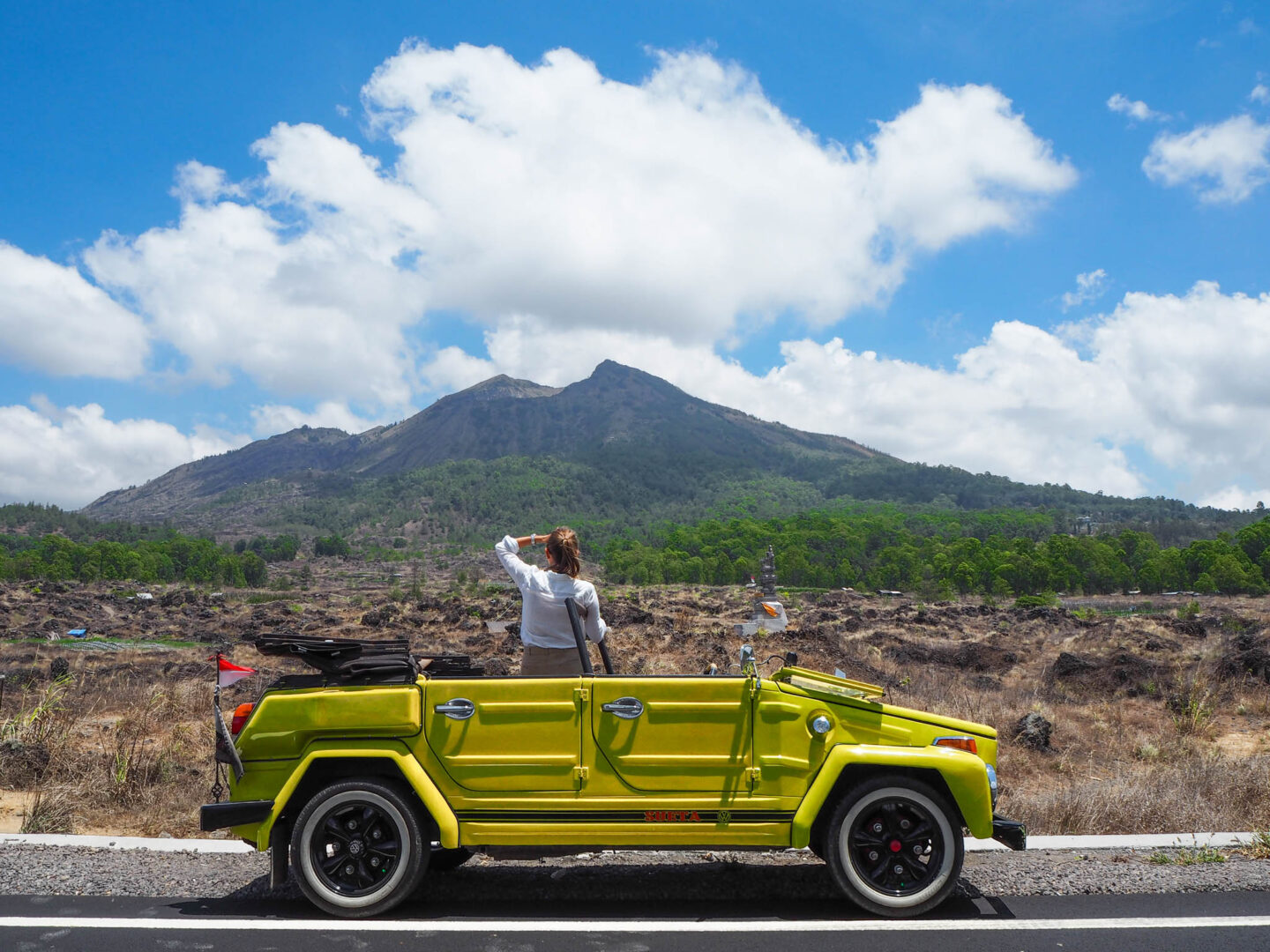
Travelling slow: Exploring Mt Batur in Bali, a less visited natural sight.
TIP NO 3: OPT FOR A TRAIN / BOAT OR AT LEAST A DIRECT FLIGHT
Even if you are not travelling slow, it is always worth exploring the possibility of travelling by boat or train instead of flying; planes are, sadly, great polluters. If flying is unavoidable, choose a direct flight as this alleviates the impact of take-off and landing which is said to generate 25% of a flight’s emissions. It is also worth the extra cost -if there is one- as it is so much more convenient. And don’t forget to offset those air miles.
To be honest, I am not the one for flight shaming. We can create a better world by learning from the mistakes of the past and looking forward. It is unreasonable to expect that we go back to a time of no civil aviation. However, we should always consider alternatives when they exist or at least ask for them. Let’s not forget that, as consumers, we have the power to shape the supply of goods and services. And we give that power to those we give our money to.
USING OUR POWER AS CONSUMERS TO PROMOTE SUSTAINABLE TRAVEL
So, opt for trains or boats, and when there is no alternative, support the airlines trying to make a difference. Let’s empower those who are making sincere efforts to reduce plastic waste or offer carbon offset schemes. Those who renew their fleets with more environmentally friendly aircrafts. And remember that annoying email from the airline asking you, how was your flight? Take 5 minutes of your day to criticise them for the single use plastic cup they served you coffee in. Or to encourage them to invest in R&D for more environmentally friendly aircrafts and fuel. If many people ask for it, they will pay attention.
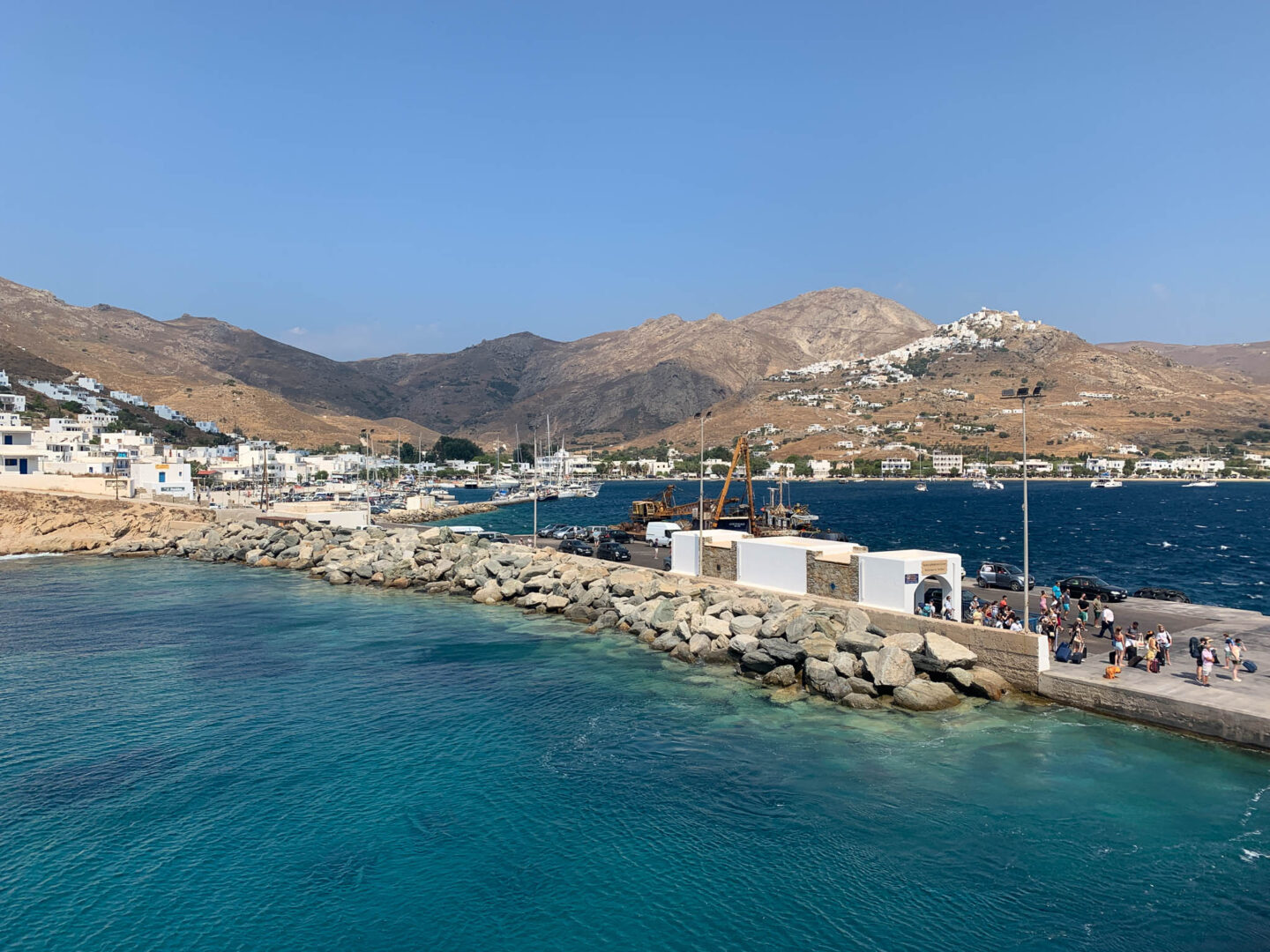
Choosing to travel by boat over plane: You can’t beat the views one enjoys for free while reaching port in the Greek islands; this is a photo of the port of Serifos.
PACKING & CONSUMING
TIP NO 4: PACK LIGHT
Having talked about carbon emissions for flights, travelling light can be the next best thing you can do for the environment and your wallet. Fuel consumption on a plane heavily depends on its weight; that is why airlines penalise us so for the extra luggage weight.
However, by packing light, you are not just doing the environment a favour, but also yourself. The whole purpose of travelling is to be carefree, yet legging around multiple pieces of luggage or even one huge suitcase literally and metaphorically weighs you down. All the sh$!t that we take with us, are a physical and mental load. We have to carry them around, find places to put them in the room (even expensive hotel rooms are getting smaller and smaller), unpack and pack them again. Why fuss over which shoes to wear rather than getting out there and explore? Trust me, once you travel light once, you won’t go back.
Interestingly, an exercise for packing light can also make you reconsider your general approach to owning clothes and… you know… stuff. Let’s face it, the vast majority of light packers are also people who have a more minimalist approach to clothing, and probably life in general. Intrigued by the thought of a minimalist lifestyle? Starting with streamlining / organising your travel gear and holiday wardrobe may be perfect as it is a less daunting and more purposeful task than trying to declutter your whole house.
WHY IS TRAVELLING LIGHT A MORE SUSTAINABLE FORM OF TRAVEL?
Not sure how that helps the planet? Apart from those airplane carbon emissions? Well, if it’s that hard to get your sh&!t into a reasonably sized suitcase, it may be because you own too much -and none of it is exactly right. Fast fashion may be one reason for this, excessive consumption of cheap (and cheerless) products that break easily may be another. No matter the reason, we all know where all these things end up. In the landfill, leaving you dissatisfied and wanting more.
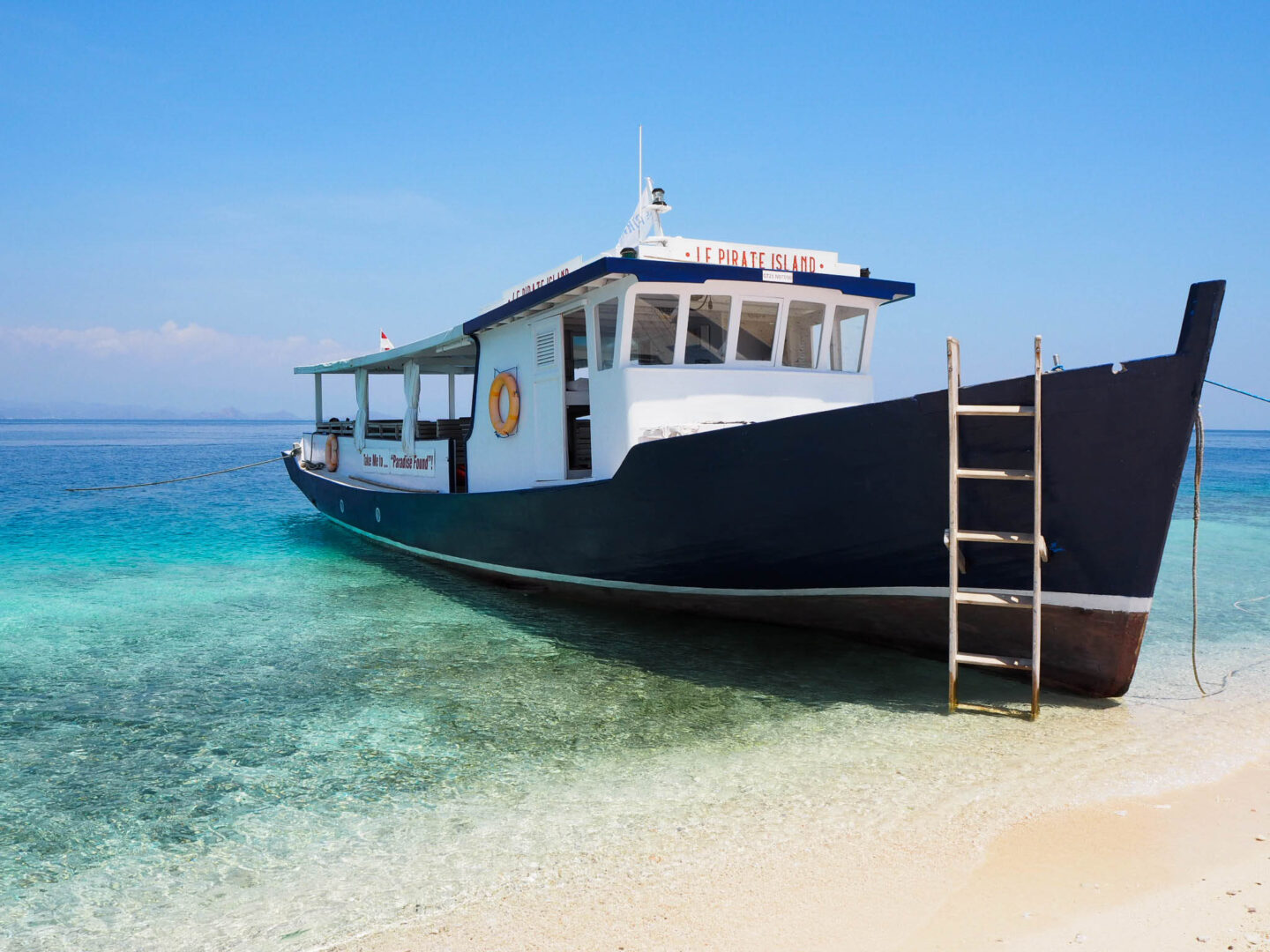
Packing light: The only way to get to stunning Le Pirate Island in Flores, Indonesia is also a big motivator for packing light!
TIP NO 5: AVOID SINGLE USE PLASTIC
Eliminating single use plastic is something we should all be doing in our everyday life let alone when travelling. Yet eradicating (or significantly reducing) usage of single use plastic is even more important when travelling. In many places around the world waste management is extremely challenging and potentially less sophisticated than back at home. Small islands, remote locations, developing countries and, of course, the backcountry should be treated with extra care as the standard in waste management may be either poor or extremely complicated and resource intensive.
Naturally, it may require a bit more effort, or rather preparation, to reduce single use plastic when we are not in our normal routine and familiar environments. Even more so since we need to fit all of our stuff in one small suitcase! Luckily, there have been so many advancements in product design specifically for this purpose that you should be in no trouble finding the right travel and eco-friendly alternatives. Or it can be as simple as going back to the old school products (eg. soap in a tin case).
HOW TO ELIMINATE SINGLE USE PLASTIC WHILE TRAVELLING
All it takes is having a more considered approach to packing and preparing for travel. Do a little bit of online research on a slow Sunday afternoon, even if you don’t intend to travel soon. Indeed, it is better if your next trip is not very soon. You will have time to do your research stress-free and test stuff. Go through all of the things you carry with you for travel; this is not just about your single use travel-sized shampoo. Think about your trip from start to finish, from the airport terminal to your hotel stay and the activities you will be doing while you are there.
If this sounds too daunting a task, just remember that perfection will never be achieved, and that is ok. Even a few small things multiplied by many people and many trips make a difference.
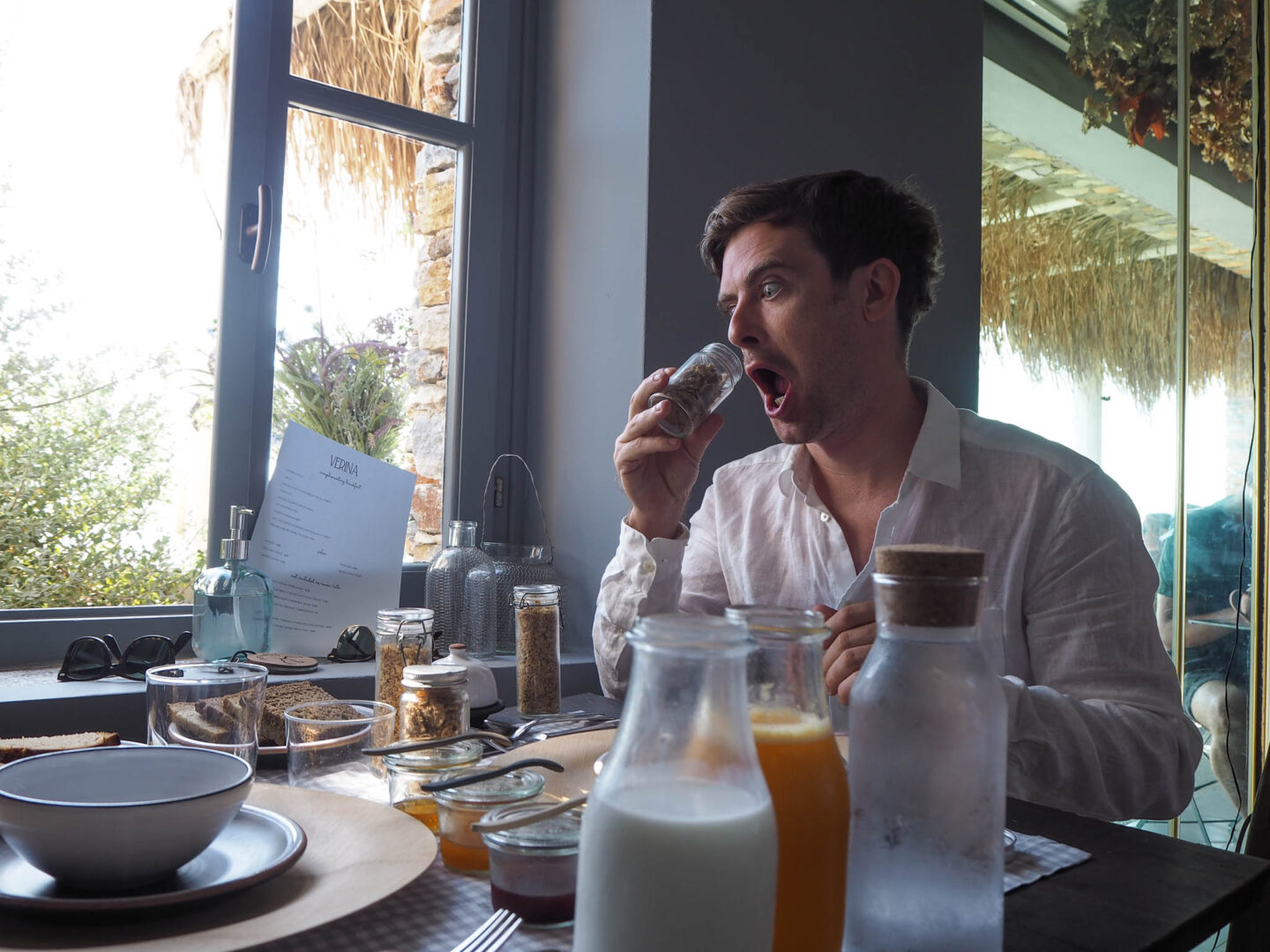
Avoiding single use plastic: My partner is enjoying a plastic-free breakfast in Verina Astra hotel, Sifnos, Greece.
TIP NO 6: CHOOSE NATURAL PRODUCTS
Did you ever wonder what happens to your shower water after it leaves your bathtub? In principle, and to keep things simple, residential sewage water, via various systems, ends up in a wastewater treatment facility where it gets treated (so that it is not harmful) and then released into the sea, a river etc. As you can imagine, not all wastewater treatment facilities are created equal and like many things in life, their standards need updating from time to time. What used to be acceptable 10 years ago might be considered inadequate today or in five years from now. In the meantime, all of our cosmetic and cleaning products end up in the ocean.
But wait, there is more. There are places in the world where sewage is dumped in the waterways untreated! And if you think that only happens in obscure villages in 3rd world countries, think again.
NOT JUST A 3RD WORLD PROBLEM
IN LONDON, ENGLAND, the combined sewage from toilets, sinks, showers and washing machines, as well as the rainwater run-off from roads, gutters and pavements is designed to occasionally flow into the river Thames untreated (!) to avoid flooding streets and homes when it has rained too much. This is because the system dates back to the Victorian times and based on the population of the day (and some extra future provision) this overflow happened once or twice a year. However, nowadays, the density of the population has surpassed that original design factor many times over (and because there are fewer green spaces to absorb rainwater naturally), it now happens every week, on average!
Shocking, right? It is only in the last couple of years that a super-sewer is being built to tackle this problem and end polluting river Thames. And there are many who suggest that it might still not be enough. Anyway, the project is called Thames Tideway and if this is all a bit too hard to believe, check out their website. For those of you who have been in London and thought Thames’ ‘unattractive’ water colour is due to the sky being grey… think again!
LET’S DO OUR PART & CHOOSE NATURAL
So, regardless of where you live or where you travel to, think a bit about the products you use. Even the most perfectly designed infrastructure has flaws and in so many cases, systems are not even remotely close to perfect. Opt for natural soap, reef safe suncreams and natural cleaning products (while at home).
There will always be a need and an obligation for the government and the scientific world to ensure that everything possible is being done to prevent harm to the natural environment. This, however, does not absolve us from doing our bit to ensure that the fewest possible ‘innocent until proven guilty’ substances find their way into the sea and our waterways…
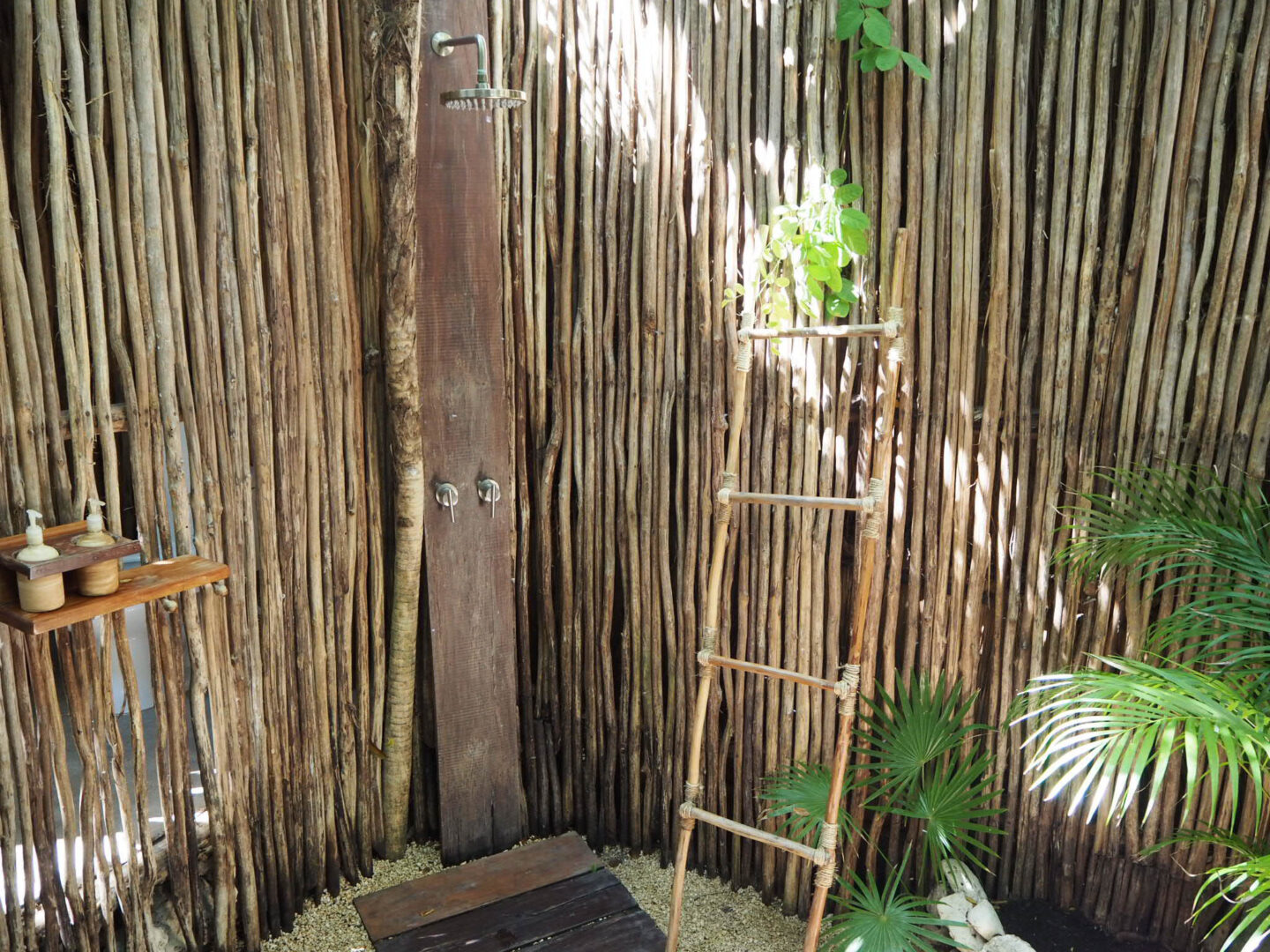
Choosing natural products: During our stay in Habitas, Tulum, we were encouraged to use their own natural, re-fillable and locally sourced shower products to avoid having synthetic substances draining into the ocean.
ENJOYING RESPONSIBLY
TIP NO 7: SUPPORT THE LOCAL ECONOMY
This may be the easiest form of sustainable travel and probably the one that everyone kind of knows instinctively already, so I will be brief. Preferring locally owned businesses over international brands whether that relates to accommodation, dining, tour operators, guides or shopping will give you by far better chances of immersing yourself in the culture of the place you are visiting. It is also the most tangible and quickest way of having a positive impact.
Choosing a locally owned hotel or renting a local property may be the biggest contribution you can do. Nevertheless, even if you are addicted to the familiar comforts of international chain hotels or cannot resist the luxurious design that sometimes seems to be more readily available by hotels of foreign interests… don’t despair. There are many ways one can mitigate this. Go local for meals, tours or shopping. Ask around or do some quick research online for places that are the real deal. Along with your selfies, promote these local businesses on your social media… Unless they are already overwhelmed by visitors -what are you even doing there, then?
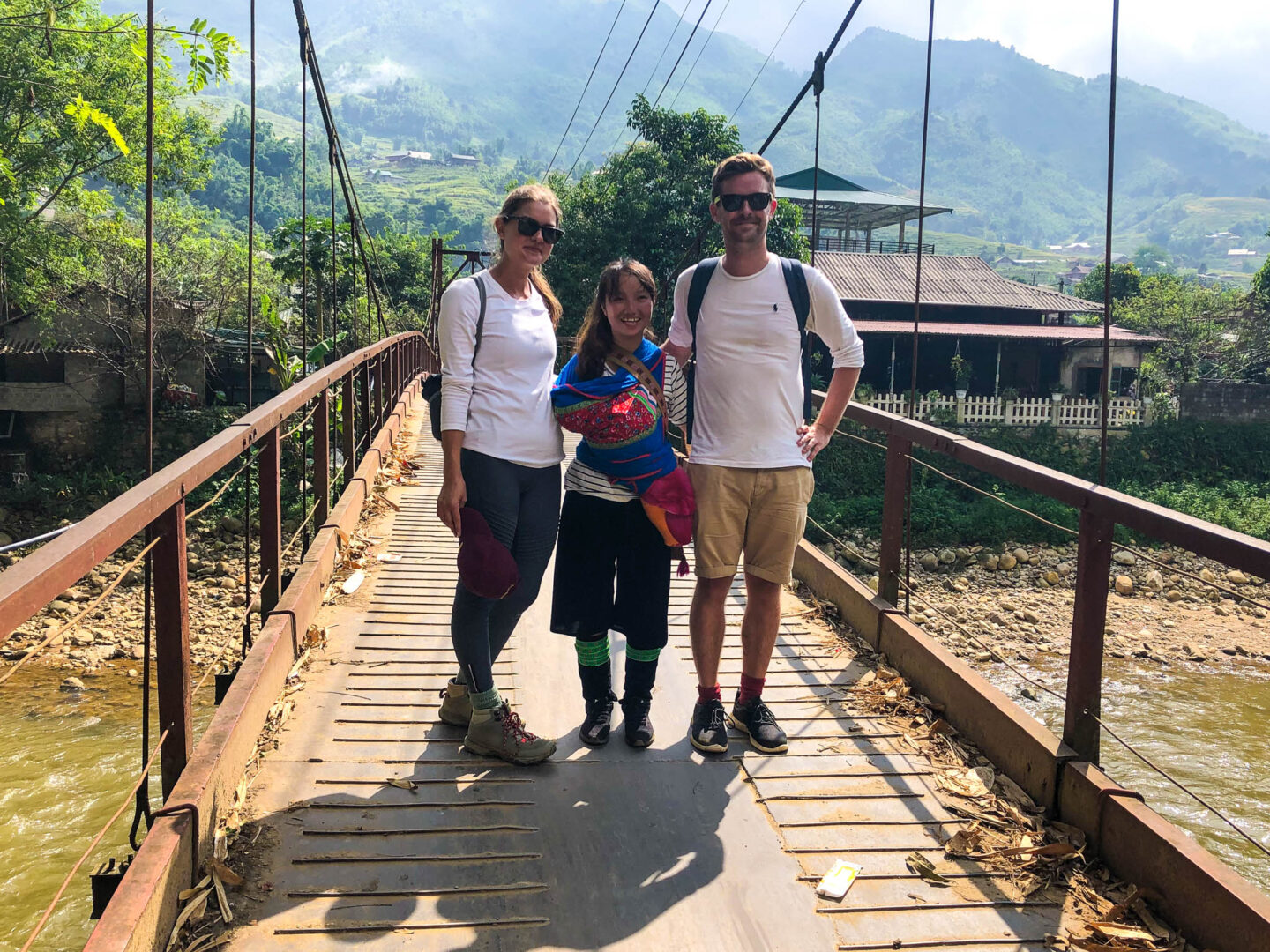
Supporting the local community: Exploring the rice fields of Sapa, Vietnam with our guide Little Chi from Sapa Sisters; a local tour operator run by women from the local minority tribes.
TIP NO 8: USE LOCAL TRANSPORTATION
Similarly to our everyday life, there are many environmental and social benefits to using local transportation while travelling rather than renting a car. Naturally, this is easier done in certain destinations rather than others. However, if you always rent a car while on holiday, consider skipping it on your next one. My boyfriend and I do not drive and have found that there are many advantages to this. We just do some research beforehand on our destination and choose accommodation and activities appropriately. Luckily for you, I write about all that, in this blog, for your information and reading pleasure!
Note that in many places around the world, it is indeed safer to avoid hiring your own car. Roads can be dangerous, extremely busy or ill-lit. Or you might simply not used to driving in certain conditions (snow, narrow mountain roads etc).
AVOIDING CAR HIRE AS A FORM OF SUSTAINABLE TRAVEL
Not hiring a car does not mean that you cannot find an alternative to suit your budget and travel style. You can use buses, urban / suburban trains etc if you wish to stick within a lower budget; this is also the more environmentally friendly approach.
If you can afford to spend more, then you will have more options, so choose wisely! Taxis, private chauffeured tours or chartering a boat might not be the most environmentally friendly options. In my opinion, however, it is better to support small local businesses rather than the international rent-a-car company which somehow manages to have a branch in places that do not even have a doctor.
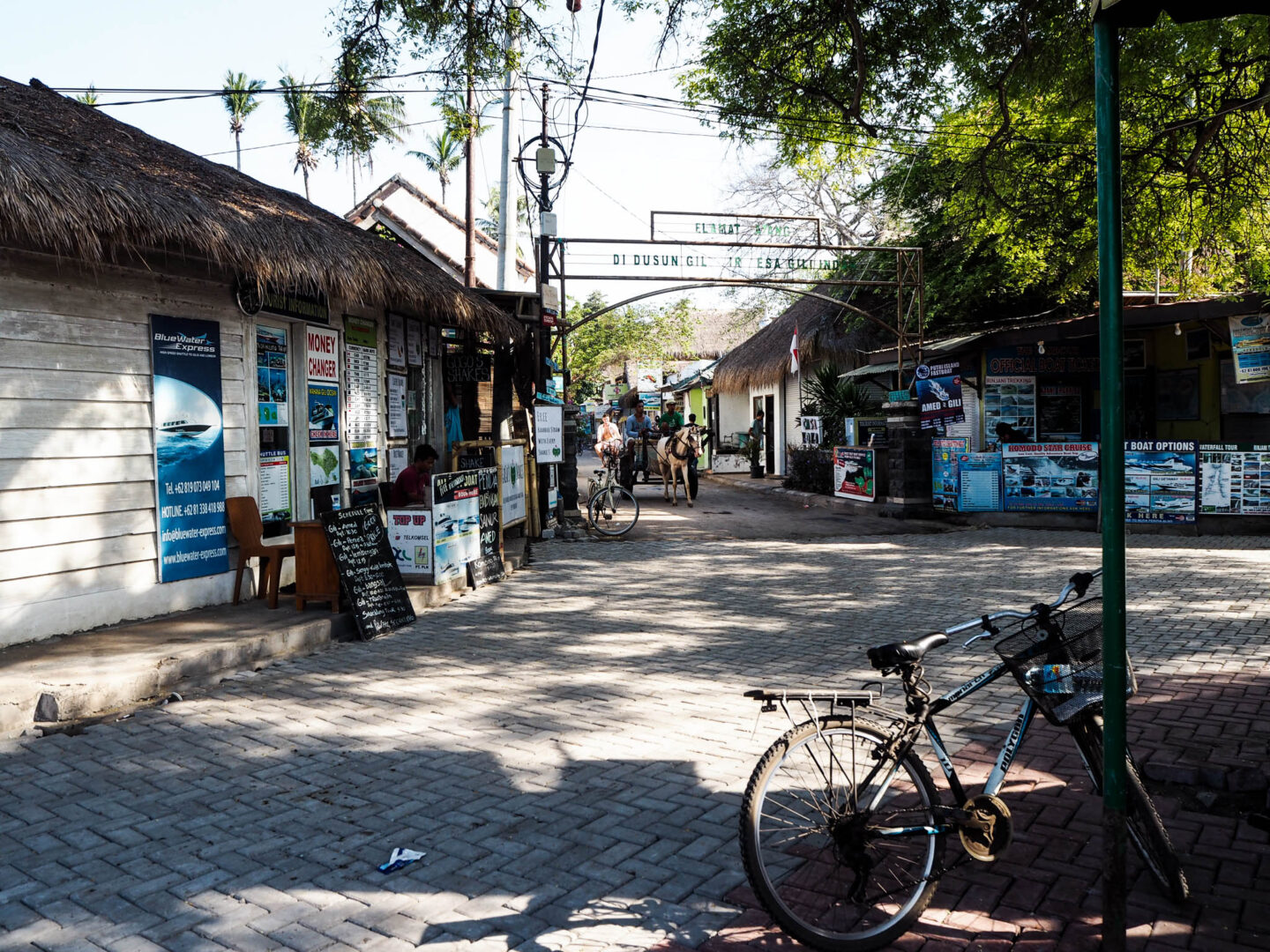
Using local transportation: Cycling and using horse drawn carriages are the only way around Gili Air, Indonesia.
TIP NO 9: EDUCATE YOURSELF ON LOCAL ACTIVITIES
Being a visitor in a foreign land is both an advantage and a drawback. The drawback is that more often than not, you are only able to see that a tour or an activity you participated in is harmful to the natural or social environment after you have done it. The advantage is that your different background gives you a fresh perspective. You, as an outsider, may be a more objective judge than the locals who have spent their whole life doing things in a particular way.
This is really important when it comes to activities set in unique natural habitats, involving animals or in remote or fragile areas, e.g. snorkelling in coral reefs, anything involving animals or even visiting sensitive cultural or archaeological sites. Before booking, it is always worth researching as much as possible to try and ensure that you are contributing to the economic welfare of people who care and protect these places or animals. Ask at your hotel, read reviews online, chat to other participants or just ask a few questions to the organisers before booking. Afterwards, provide feedback. Praise the ones who deserve it or raise awareness about practices that should not be supported.
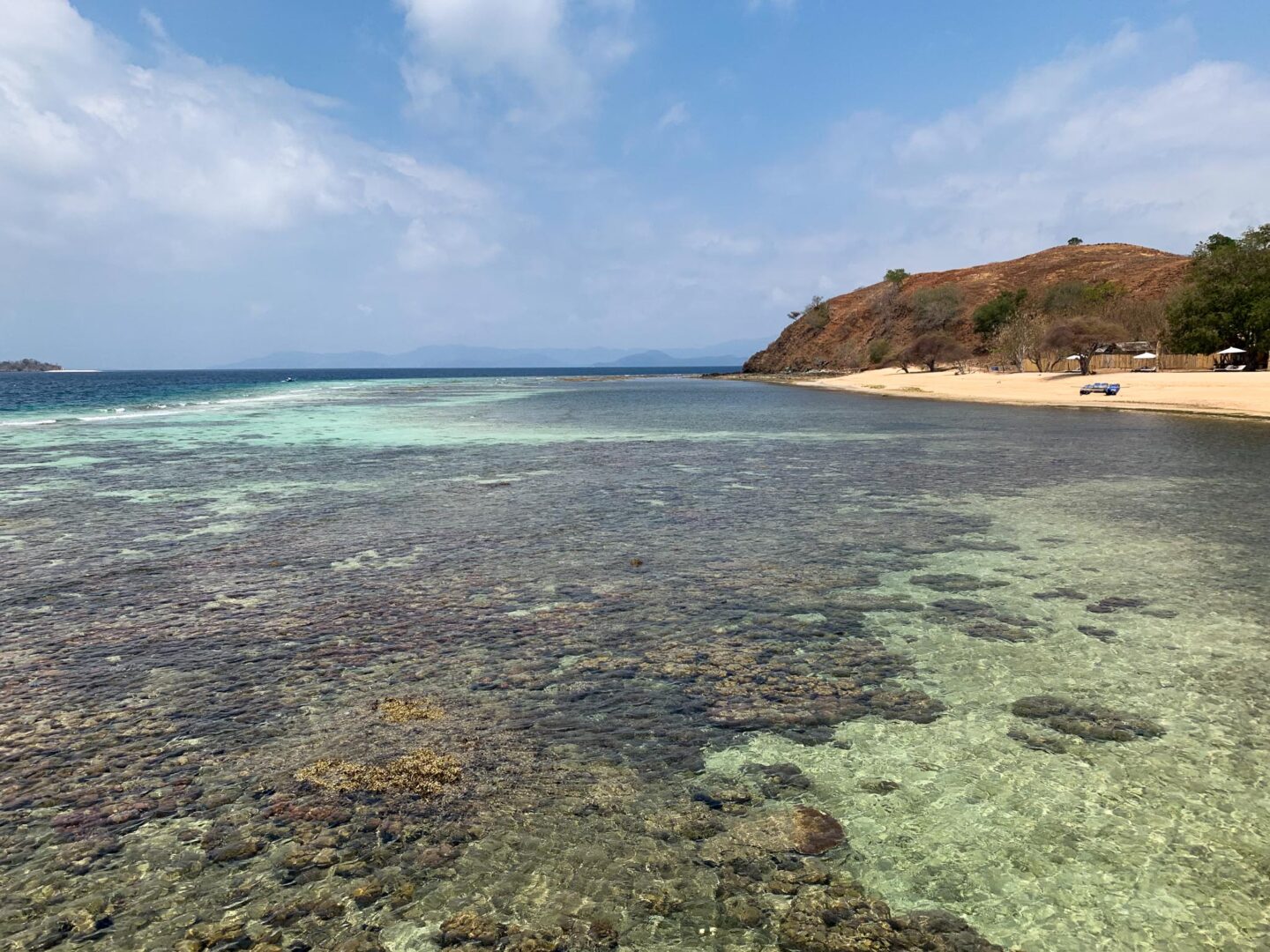
Educating ourselves on local activities: The coral reef in Seraya, Flores, Indonesia is naturally bustling with life yet there are parts where an ongoing restoration project is giving a helping hand to Mother Nature.
EXPLORING MINDFULLY
TIP NO 10: (SUSTAINABLE) TRAVEL
It has become a bit of a trend, nowadays, to talk about tourism ruining the environment and disturbing local societies. Yet, as with everything in life, you can find bad apples even in the healthiest of trees. There is no better way to educate ourselves on the problems that natural habitats face than getting out there and seeing them for ourselves. There is no quicker way to empathise and contribute in a positive manner to issues that local communities face than getting to know them in person.
We won’t feel the climate change emergency in our city apartments. How many of us actually cared about coral reefs before snorkelling in one? We won’t know the point of reusable water bottles until plastic bottles wash up next to us while sipping cocktails on a tropical beach. As long as we are respectful, thoughtful and do a tiny bit of preparation, then we can only have a positive impact to the places we travel to. And they shall have a positive impact on us in return…
This is not a sponsored post & I am not affiliated with any of the hotels, restaurants or organisations mentioned.
LET’S TALK ABOUT TRAVEL
Looking for ways to improve the way you travel? Hit the button below!
___
